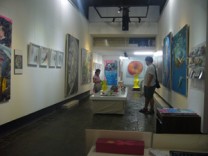您所在的位置:One gallery>画廊动态>正文
Chinese Artists Capitalize on Avant-garde Boom
2011-04-15 11:33:10
It only takes two days for Chen Quan to crank out a reproduction of a Yue Minjun.
"I have done hundreds of his paintings," says the shirtless 25-year-old, his hair tied in a ponytail, referring to the Chinese artist renowned for his paintings of absurd, grinning faces.
Standing by a half-finished copy that features men smiling sardonically while perched in a boat on a lake, Chen adds: "Copies like this aren't really hard at all. It just takes time."
While reproductions like Chen's go for only about 250 yuan ($33) apiece in Dafen, where copies of paintings by anyone from Da Vinci to Norman Rockwell are churned out in the dozens, prices of genuine works by China's top artists are soaring.
At Sotheby's contemporary art auction in London last week seven works by some of China's top painters, including Yue and Zhang Xiaogang, raked in 4.86 million pounds ($9.68 million) -- more than double their pre-sale estimate.
Yue's 1997 oil on canvas entitled "The Pope" sold for 2.15 million pounds ($4.28 million).
Another piece by Yue, depicting an open head with a pool of blue water in which late Chinese revolutionary leader Mao Zedong is having a dip, fetched 692,000 pounds -- almost five times the high end of the pre-auction estimate.
These prices come after previous auction records were set in May at a Christie's auction in Hong Kong.
Copies Popular
"Chinese art these past few years has been extremely hot," says Wei Guangqing, another well-known painter and contemporary of Yue's who serves as dean of the Hubei Institute of Fine Arts.
The appearance of knock-offs of Chinese paintings in Dafen, an urban "village" in the southern boomtown of Shenzhen known for its reproductions of Western oil paintings, is a testament to their blossoming popularity
The streets here are lined with shops, and on second and third floors, thousands of young artists churn out phoney Van Goghs, Monets, Dalis and generic hotel room art, often in assembly lines that would have made Henry Ford proud.
Chen says reproductions of the works of Chinese contemporary big-hitters make up more than 30 percent of his small shop's sales, although the walls are covered with realist nudes and Renaissance reproductions.
Other art dealers in Dafen estimate contemporary Chinese works make up 10-20 percent of their sales, and say they have been a steady staple since demand for the paintings emerged on the Dafen scene a couple of years ago.
In theory, there are copyright issues in copying, but in reality nobody here has any problems.
"When leaders or cultural officials come they say: 'These items are copyrighted, so just don't put them on top'," says one gallery owner.
Foreign Buyers
The contemporary Chinese knock-offs -- the retro-revolutionary Wang Guangyis, the precocious baby-populated Tang Zhigangs, the colourful Fang Lijuns and the sneering Yue Minjuns -- are popular with foreigners and Hong Kongers.
"These are a little alternative," says Huang Zhenyi, who tends a gallery on one of Dafen's main streets.
Clicking on computer images of Yue Minjun art that customers can order, he adds: "Many foreigners who come here know a lot about this guy, but Chinese people don't know him. They just see all those teeth and the smile and think it's funny."
At Thursday's auction, the Chinese works were bought by Asians, but not mainland Chinese, says Evelyn Lin, head of the contemporary Chinese art department at Sotheby's Asia.
But, she says, there is growing appetite for contemporary Chinese art among mainlanders.
"Chinese consumers have just started to pay attention recently ... the mainland Chinese have learned to appreciate Chinese contemporary art," Lin says.
China's fast-growing economy is buoying the art market from the rarefied stratosphere all the way down to would-be starving art students.
"All my graduate students can sell paintings these days," says Wei. "But I think they are being influenced by the market too soon ... Youth today lack a lot of experience. Their evaluations of things are realistic, practical."
In Dafen, Chen is just focused on cranking out replicas as quickly as he can. He says he doesn't have time to work on his own art but he'd like to because he is under no illusions about what he does.
"This is just a craft," he says. "It's not really art."

 黄琦
黄琦 测试用艺术
测试用艺术
